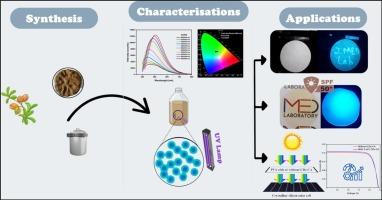Efficient hydrothermal synthesis of carbon dots from argan cake and their applications
IF 5.1
3区 材料科学
Q2 MATERIALS SCIENCE, COATINGS & FILMS
引用次数: 0
Abstract
Argan cake-based fluorescent carbon dots (CDs-CA) were successfully synthesized by a simple, environmentally friendly, one-step hydrothermal method at 180 °C for 12 h, using argan waste as a biobased precursor. The CDs obtained show intense blue fluorescence under 365 nm UV light. Several structural characterization techniques, including EDX, FTIR, electrokinetic titration, and NMR spectroscopy, were employed to study their chemical structures and identify the functional groups. The thermal properties of the CDs-CA were evaluated by TGA. TEM analysis confirmed their nanometric size, with an average size of 4.64 nm. Furthermore, the UV–vis spectroscopy and photoluminescence (PL) analysis were used to investigate the optical properties. These later showed an excitation-dependent PL behavior. Additionally, the fluorescence lifetime exhibits two decay time constants (τ1 = 4.56 ns and τ2 = 9.94 ns), and the average value (τavg = 11.40 ns) suggests that surface functional groups primarily govern the emission. The synthesized CDs-CA were incorporated into PVA to form nanocomposite films (PVA@CDs-CA), which exhibited excellent mechanical properties at 2 wt% of CDs-CA. The CDs-CA were successfully applied in three areas. Firstly, as inks that are invisible to normal light but fluoresce under UV light, demonstrating their high potential for anti-counterfeiting applications, particularly in sensitive documents such as passports and banknotes. Then, as high-performance UV-blocking PVA nanocomposite films with a sun protection factor exceeding 50, while maintaining over 82 % visible transmittance. Finally, as a downshifting layer on silicon solar cells, it improves energy conversion efficiency from 11.45 % to 12.21 %.

从摩洛哥坚果饼中高效水热合成碳点及其应用
以摩洛哥坚果废料为生物基前驱体,采用简单、环保的一步水热法,在180℃下合成了摩洛哥坚果饼基荧光碳点(CDs-CA)。所得CDs在365 nm紫外光下显示出强烈的蓝色荧光。利用EDX、FTIR、电动滴定、NMR等结构表征技术对其化学结构进行了研究,并对其官能团进行了鉴定。用热重分析仪对CDs-CA的热性能进行了评价。TEM分析证实了它们的纳米尺寸,平均尺寸为4.64 nm。此外,利用紫外-可见光谱和光致发光(PL)分析对其光学性质进行了研究。这些后来表现出一种依赖于激励的PL行为。此外,荧光寿命表现出两个衰减时间常数(τ1 = 4.56 ns和τ2 = 9.94 ns),平均值(τavg = 11.40 ns)表明,表面官能团主要控制发射。将合成的CDs-CA掺入PVA中形成纳米复合膜(PVA@CDs-CA),当cd - ca含量为2 wt%时,纳米复合膜具有优异的力学性能。cd - ca在三个领域得到了成功的应用。首先,作为油墨,在正常光线下是不可见的,但在紫外线下会发出荧光,这表明它们在防伪应用方面具有很高的潜力,特别是在护照和纸币等敏感文件上。然后,作为高性能的阻挡紫外线的PVA纳米复合膜,其防晒系数超过50,同时保持82%以上的可见光透过率。最后,作为硅太阳能电池的降移层,将能量转换效率从11.45%提高到12.21%。
本文章由计算机程序翻译,如有差异,请以英文原文为准。
求助全文
约1分钟内获得全文
求助全文
来源期刊

Diamond and Related Materials
工程技术-材料科学:综合
CiteScore
6.00
自引率
14.60%
发文量
702
审稿时长
2.1 months
期刊介绍:
DRM is a leading international journal that publishes new fundamental and applied research on all forms of diamond, the integration of diamond with other advanced materials and development of technologies exploiting diamond. The synthesis, characterization and processing of single crystal diamond, polycrystalline films, nanodiamond powders and heterostructures with other advanced materials are encouraged topics for technical and review articles. In addition to diamond, the journal publishes manuscripts on the synthesis, characterization and application of other related materials including diamond-like carbons, carbon nanotubes, graphene, and boron and carbon nitrides. Articles are sought on the chemical functionalization of diamond and related materials as well as their use in electrochemistry, energy storage and conversion, chemical and biological sensing, imaging, thermal management, photonic and quantum applications, electron emission and electronic devices.
The International Conference on Diamond and Carbon Materials has evolved into the largest and most well attended forum in the field of diamond, providing a forum to showcase the latest results in the science and technology of diamond and other carbon materials such as carbon nanotubes, graphene, and diamond-like carbon. Run annually in association with Diamond and Related Materials the conference provides junior and established researchers the opportunity to exchange the latest results ranging from fundamental physical and chemical concepts to applied research focusing on the next generation carbon-based devices.
 求助内容:
求助内容: 应助结果提醒方式:
应助结果提醒方式:


